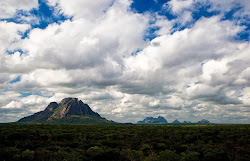Glenn Overstreet
27828 Tunoi Pl.
North Fork, California 93643
I finally met Jeff Davis. This was over in Lee Vining at a restaurant. It took me a while to figure out who he was until he climbed into an official truck with a dog-box. Mrs. Davis, Vicky, was was with him and we had a nice chat. Jeff is one of the USDA Wildlife Specialists working on the Sierra Nevada Bighorn Sheep Project trying to keep the lions from finishing off the last of the endangered sheep. Vicky is his Dept. of Fish & Game assistant.
Another team with Jeff Ostergaurd and a F&G assistant are also part of the group working on this important project.
Last winter Vicky was climbing around some rocks, up in the snow, while following the Hounds and stepped into a hole that turned out to be an old camp of Charlie Tant. Charlie would camp just about anywhere the lion hunting was good and wasn't too particular about comfort. Usually a cave or a hole in the rocks but occasionally under a tree root. Jeff is a fortunate man to have such a lady for a wife and hunting companion.
Dick Muldoon sent me some photos of a Tant camp that he took his family to several years ago. It was an overhanging rock with water nearby and Tant's cooking utensils were still there. He would leave the essentials for cooking at each of his camps Years ago Steve Matthis told me he was hunting over on the California coast and while going over some rocks he found a sooty chimney in a hole of the rocks. He climbed around until he found the entrance. Expecting an Indian site he was surprised to see TANT scratched on the walls. These camps are around, and I suppose deer hunters find them and don't know what they are looking at. Ben Lilley camped the same way and his camps were found for years after he was gone. Charlie's sister Mrs. Mercer of Medford, Oregon, told me that Charlie had hunted with "Mr. Lilly." They certainly hunted and lived alike.
A good rule for going through life is to keep the heart a little softer than the head. You know when your trying real hard to hear your dogs away off in some tough canyon it helps if you cup your hands behind your ears. It also helps if you open your mouth about 1". It has something to do with the ear bone connected to the jaw bone-the jaw bone connected to the head bone- the head bone, etc. No kidding.
27828 Tunoi Pl.
North Fork, California 93643
I finally met Jeff Davis. This was over in Lee Vining at a restaurant. It took me a while to figure out who he was until he climbed into an official truck with a dog-box. Mrs. Davis, Vicky, was was with him and we had a nice chat. Jeff is one of the USDA Wildlife Specialists working on the Sierra Nevada Bighorn Sheep Project trying to keep the lions from finishing off the last of the endangered sheep. Vicky is his Dept. of Fish & Game assistant.
Another team with Jeff Ostergaurd and a F&G assistant are also part of the group working on this important project.
Last winter Vicky was climbing around some rocks, up in the snow, while following the Hounds and stepped into a hole that turned out to be an old camp of Charlie Tant. Charlie would camp just about anywhere the lion hunting was good and wasn't too particular about comfort. Usually a cave or a hole in the rocks but occasionally under a tree root. Jeff is a fortunate man to have such a lady for a wife and hunting companion.
Dick Muldoon sent me some photos of a Tant camp that he took his family to several years ago. It was an overhanging rock with water nearby and Tant's cooking utensils were still there. He would leave the essentials for cooking at each of his camps Years ago Steve Matthis told me he was hunting over on the California coast and while going over some rocks he found a sooty chimney in a hole of the rocks. He climbed around until he found the entrance. Expecting an Indian site he was surprised to see TANT scratched on the walls. These camps are around, and I suppose deer hunters find them and don't know what they are looking at. Ben Lilley camped the same way and his camps were found for years after he was gone. Charlie's sister Mrs. Mercer of Medford, Oregon, told me that Charlie had hunted with "Mr. Lilly." They certainly hunted and lived alike.
A good rule for going through life is to keep the heart a little softer than the head. You know when your trying real hard to hear your dogs away off in some tough canyon it helps if you cup your hands behind your ears. It also helps if you open your mouth about 1". It has something to do with the ear bone connected to the jaw bone-the jaw bone connected to the head bone- the head bone, etc. No kidding.




































g~~60_12.JPG)
















